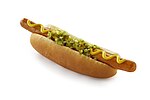Stealing Home (statue)
2017 sculpturesBronze sculptures in CaliforniaCultural depictions of Jackie RobinsonMonuments and memorials in Los AngelesOutdoor sculptures in Greater Los Angeles ... and 4 more
Sculptures of men in CaliforniaStatues in CaliforniaStatues of sportspeopleUnited States sculpture stubs
Stealing Home: The Point of No Return is a bronze statue of baseball great Jackie Robinson which was unveiled outside Dodger Stadium on April 15, 2017, the 70th anniversary of Robinson's breaking of the color barrier in Major League Baseball. In 1947, Robinson become the first African-American to play in Major League Baseball during the modern era. He played for the Brooklyn Dodgers from 1947 to 1956 and was elected to the Baseball Hall of Fame in 1962. His historical first is commemorated on Jackie Robinson Day each year.
Excerpt from the Wikipedia article Stealing Home (statue) (License: CC BY-SA 3.0, Authors).Stealing Home (statue)
Academy Road, Los Angeles Echo Park
Geographical coordinates (GPS) Address External links Nearby Places Show on map
Geographical coordinates (GPS)
| Latitude | Longitude |
|---|---|
| N 34.074972222222 ° | E -118.23922222222 ° |
Address
Academy Road
90026 Los Angeles, Echo Park
California, United States
Open on Google Maps







